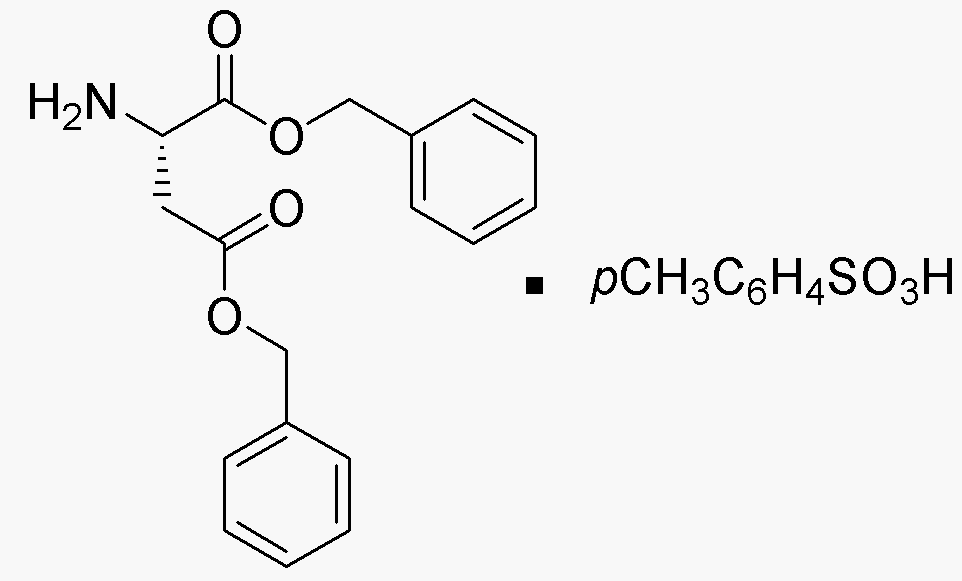L-Aspartic acid dibenzyl ester 4-toluenesulfonate salt is widely utilized in research focused on:
- Pharmaceutical Development: This compound serves as an intermediate in the synthesis of various pharmaceuticals, particularly those targeting neurological disorders, enhancing drug efficacy and bioavailability.
- Biochemical Research: It is used in studies involving amino acid metabolism, providing insights into metabolic pathways and potential therapeutic targets for metabolic diseases.
- Protein Engineering: The ester form aids in modifying proteins for enhanced stability and activity, making it valuable in the development of biocatalysts and therapeutic proteins.
- Cosmetic Formulations: Its properties make it suitable for use in skin care products, where it acts as a moisturizing agent, improving skin hydration and texture.
- Food Industry: As a flavor enhancer, it can be incorporated into food products to improve taste profiles, appealing to manufacturers looking to enhance product quality.
General Information
Properties
Safety and Regulations
Applications
L-Aspartic acid dibenzyl ester 4-toluenesulfonate salt is widely utilized in research focused on:
- Pharmaceutical Development: This compound serves as an intermediate in the synthesis of various pharmaceuticals, particularly those targeting neurological disorders, enhancing drug efficacy and bioavailability.
- Biochemical Research: It is used in studies involving amino acid metabolism, providing insights into metabolic pathways and potential therapeutic targets for metabolic diseases.
- Protein Engineering: The ester form aids in modifying proteins for enhanced stability and activity, making it valuable in the development of biocatalysts and therapeutic proteins.
- Cosmetic Formulations: Its properties make it suitable for use in skin care products, where it acts as a moisturizing agent, improving skin hydration and texture.
- Food Industry: As a flavor enhancer, it can be incorporated into food products to improve taste profiles, appealing to manufacturers looking to enhance product quality.
Documents
Safety Data Sheets (SDS)
The SDS provides comprehensive safety information on handling, storage, and disposal of the product.
Product Specification (PS)
The PS provides a comprehensive breakdown of the product’s properties, including chemical composition, physical state, purity, and storage requirements. It also details acceptable quality ranges and the product's intended applications.
Certificates of Analysis (COA)
Search for Certificates of Analysis (COA) by entering the products Lot Number. Lot and Batch Numbers can be found on a product’s label following the words ‘Lot’ or ‘Batch’.
Número de catálogo
Número de lote/lote
Certificates Of Origin (COO)
This COO confirms the country where the product was manufactured, and also details the materials and components used in it and whether it is derived from natural, synthetic, or other specific sources. This certificate may be required for customs, trade, and regulatory compliance.
Número de catálogo
Número de lote/lote
Safety Data Sheets (SDS)
The SDS provides comprehensive safety information on handling, storage, and disposal of the product.
DownloadProduct Specification (PS)
The PS provides a comprehensive breakdown of the product’s properties, including chemical composition, physical state, purity, and storage requirements. It also details acceptable quality ranges and the product's intended applications.
DownloadCertificates of Analysis (COA)
Search for Certificates of Analysis (COA) by entering the products Lot Number. Lot and Batch Numbers can be found on a product’s label following the words ‘Lot’ or ‘Batch’.
Número de catálogo
Número de lote/lote
Certificates Of Origin (COO)
This COO confirms the country where the product was manufactured, and also details the materials and components used in it and whether it is derived from natural, synthetic, or other specific sources. This certificate may be required for customs, trade, and regulatory compliance.


